Momentum and energy fluxes in the presence of surfactants
In low to moderate wind conditions, the coupled air-water viscous layers on either side of the sea surface microlayer (SML) carry the bulk of the wind stress, which is, in turn, strongly modulated by the surface waves (Buckley & Veron, 2016, 2017, 2019, 2020). Dynamic processes at scales of millimeters to a few centimeters are driven by wind stress, and they are of key importance for a deep understanding of SML dynamics and air–sea exchange processes. Monomolecular surface films at the sea surface, which are also referred to as marine monolayers, may cover the (multilayer/micrometer) SML and dampen small-scale surface waves, thereby affecting those exchange processes (Gade et al., 2006, 2013). While the general effect of monolayers on small-scale surface roughness, wind stress, and gas fluxes is fairly well known, there is a lack of knowledge about their influence on processes that take place at very short length scales, on the order of millimeters and below.
We will close this gap through a series of laboratory experiments at the University of Hamburg’s wind-wave tank facility, in which state-of-the-art observation techniques will allow an unprecedented view on small-scale dynamics in the SML and its immediate vicinity. The relevance originates from transport processes into, accumulation processes within, and exchange processes across the SML, which are mainly driven by, and therefore depend on, small-scale dynamics at the sea surface. Understanding those processes requires an in-depth knowledge of the small-scale surface wave and near-surface current fields, along with turbulence patterns both above and below the (dynamic) water surface. Their investigation requires measurements at spatial scales in the millimeter range and below, as well as experiments under controlled (wind and wave) conditions, which can only be achieved in laboratory facilities such as the wind-wave tank of the University of Hamburg. We will investigate small-scale (cm to sub-mm) physical processes at the wavy air–water interface, which modulate and control exchange processes investigated by other SPs, and which are altered by marine monolayers commonly found in coastal waters.
Viscous and turbulent stress
In recent years, a number of in situ laboratory and numerical studies have focused on identifying the details of momentum and energy fluxes between the ocean and the atmosphere. Experiments employing particle image velocimetry (PIV) techniques within the first millimeters above or below the wavy water surface, in wind-wave tanks (see, for example, Figure 1, left panel), have shown that viscous stress dominates the air-water momentum flux in low to moderate winds and that the coupled air-water viscous and turbulent boundary layers are strongly modulated by small-scale surface waves (e.g., Buckley et al., 2020). Turbulent, intermittent airflow separation events over steep micro-breaking waves (see the upper right panel in Figure 1) further complicate momentum and energy flux mechanisms, as they often cause a dramatic drop in viscous stress downwind of wave crests (lower right panel in Figure 1, and Buckley et al., 2020).
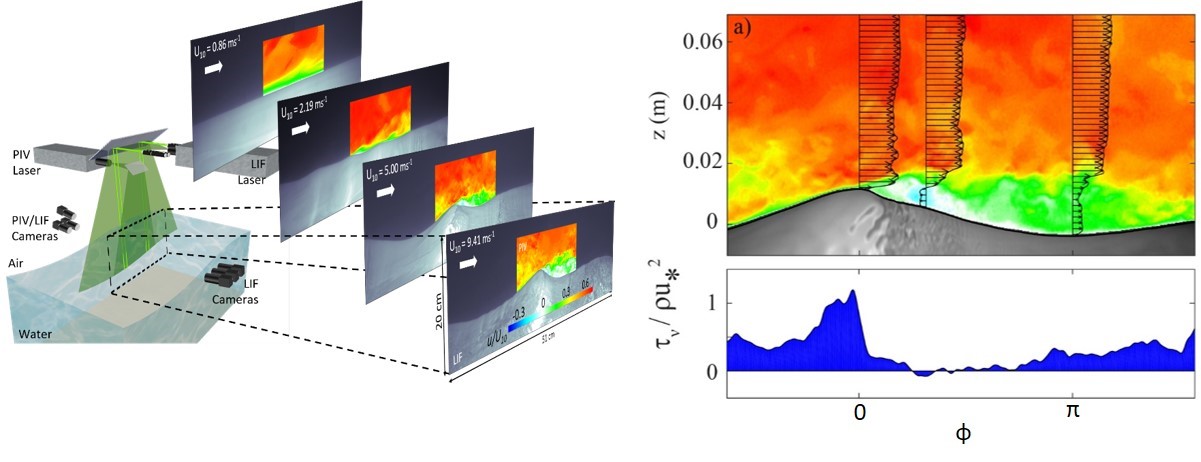
Figure 1. Combined particle image velocimetry (PIV) – laser-induced fluorescence (LIF) system developed for the study of airflow dynamics above wind-waves in the wind-wave tank, positioned at a fetch of 22.7 m (left), and an example of instantaneous two-dimensional velocity field (upper panel, right) and near-surface viscous stress estimate along an airflow-separating wind-generated wave (lower panel, right) (wind speed U10 = 5 m/s, Buckley et al., 2020).
Numerical simulations and in situ observations have also pointed to the importance of the interplay between waves and air-water turbulent and viscous motions for the transfer of momentum and energy between the atmosphere and the ocean (Husain et al., 2019). Yet, the role of surfactants in influencing the complex feedback mechanisms between waves and the coupled air-water viscous and turbulent boundary layers remains to be investigated.
Surfactants
The damping of gravity-capillary ocean waves by marine surface films has been the subject of various scientific research efforts for many decades (Gade et al., 1998c, 1998d, 2013). Experiments in wind-wave tank facilities revealed that Marangoni damping is the dominant mechanism for the damping of short gravity sinusoidal waves by monomolecular surface films (Gade et al., 1998a, 1998b). The damping of natural, i.e., non-sinusoidal, wind-generated waves in the presence of monolayers, however, cannot be explained by Marangoni damping theory alone, as the surface films also strongly affect energy fluxes from the wind into the waves and within the wave field through nonlinear interactions and wave breaking (Gade et al., 1998d). Figure 2 shows spectra of wind waves measured in the University of Hamburg’s wind-wave tank with and without monolayers at reference wind speeds of 5 m/s and 8 m/s. Note the strong decrease in spectral power density at intermediate frequencies in the presence of different monolayers. The reduced energy input by the wind causes the high-frequency part of the spectra to be comparable to that of a wave spectrum measured without monolayers, but at a lower wind speed. A smoothed water surface results in a reduced wind friction velocity, u*, hence in a reduced energy input by the wind (Gade et al., 1998a).
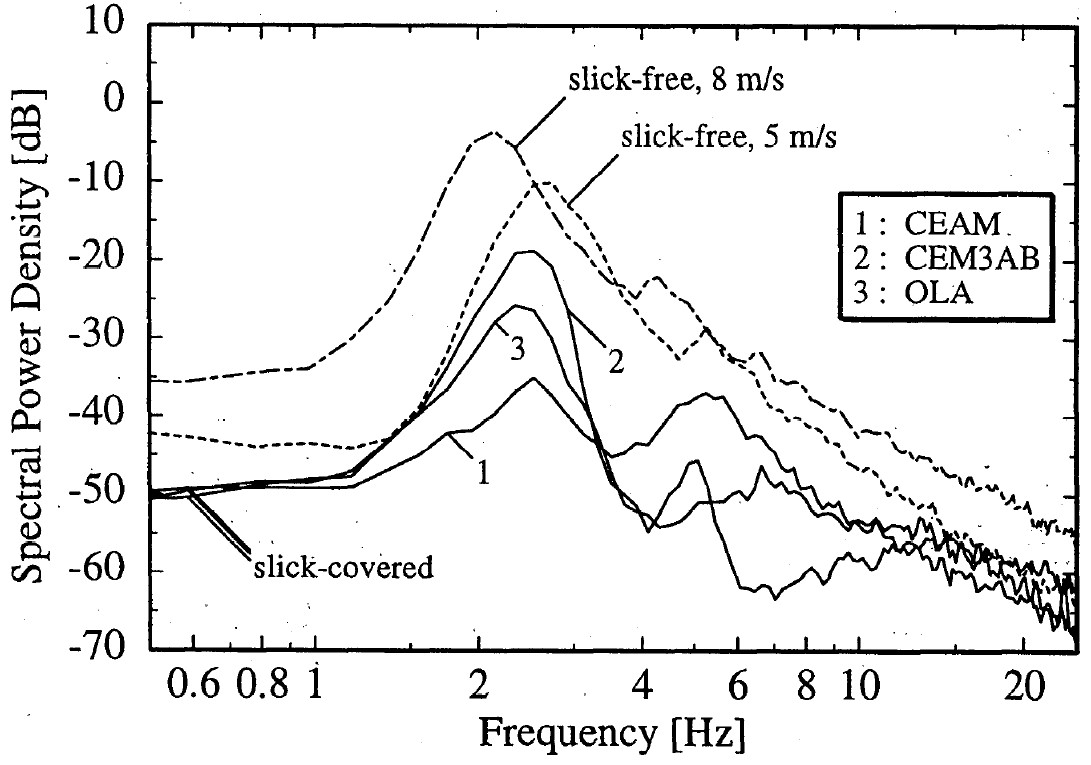
Figure 2. Wave height spectra for slick-free and slick-covered water surfaces. The solid curves correspond to 8 m/s reference wind speed and slick-covered water surfaces, the dash-dotted curve corresponds to 8 m/s reference wind speed and a slick-free water surface, and the dotted curve corresponds to 5 m/s reference wind speed and a slick-free water surface. Deployed surfactants were cetyl amine (CEAM), cetyl tri-methyl ammonium bromide (CEM3AB), and oleyl alcohol (OLA). Taken from Gade et al. (1998a).
Bound waves and micro-breaking
Steep decimeter waves at the water surface may generate trains of smaller gravity-capillary waves, which then propagate along the steep forward slopes of the long, generating waves. Those bound, or parasitic, capillary waves have been the subject of various laboratory experiments (Gade et al., 1998b), in which their generation was studied under various wind and wave conditions. Since the speed at which the bound waves propagate is that of the parent wave, they can be separated from freely propagating waves using coherent microwave sensors that record the Doppler signal caused by the small-scale scatterers (Gade et al., 1998b). Example results of such experiments are shown in Figure 3, where the wind-speed dependence of the Doppler shift measured at two different microwave frequencies is shown. The upper panel demonstrates that at low wind speeds, the small (2.5 cm) waves, which are responsible for the radar return, are mostly bound to the dominant wind waves; while at higher wind speeds, they can be both bound or freely propagating. Waves of smaller length do not show such a distinct behavior (lower panel). Further experiments demonstrated that monolayers can strongly affect the generation of bound waves, since they dampen the longer (parent) waves and reduce the surface tension (Gade et al., 1998b).
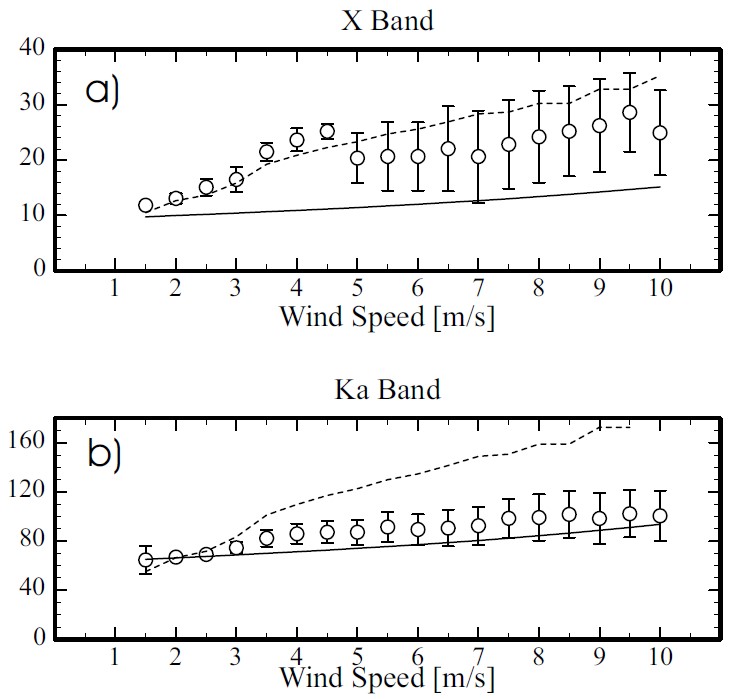
Figure 3. Wind speed-dependent radar Doppler shifts measured with two microwave scatterometers operating at (a) X band and (b) Ka band (Bragg wavelengths of 2.7 cm and 0.8 cm, respectively). Two curves are inserted into each panel, showing theoretical Doppler shifts of bound (dashed) and freely propagating (solid) Bragg waves. Note that the fraction of bound waves depends on both the wind speed and their wavelength. Taken from Gade et al. (1998b).
First test of experimental setup with combined PIV and LIF
In order to test whether our experimental approach would work in the University of Hamburg’s wind-wave tank, two preliminary experiments were performed. The first experiment employed a combination of laser-induced fluorescence (LIF) and water-side particle image velocimetry (PIV) systems, which measured wind-wave dynamics at a fetch of 15.5 m (see the setup in Figure 4, left and middle). Preliminary results showed a dramatic qualitative difference in the LIF images of the wind-waves in the presence (resp. absence) of the surfactant (oleyl alcohol) at the surface, as shown in the lower (resp. upper) right panel of Figure 4. This confirms that the surfactants strongly modify sub-millimeter-scale surface roughness features. Only coupled, high-resolution air-water PIV measurements will shed light on the interplay between these surface features and the air and water momentum and energy flux dynamics.
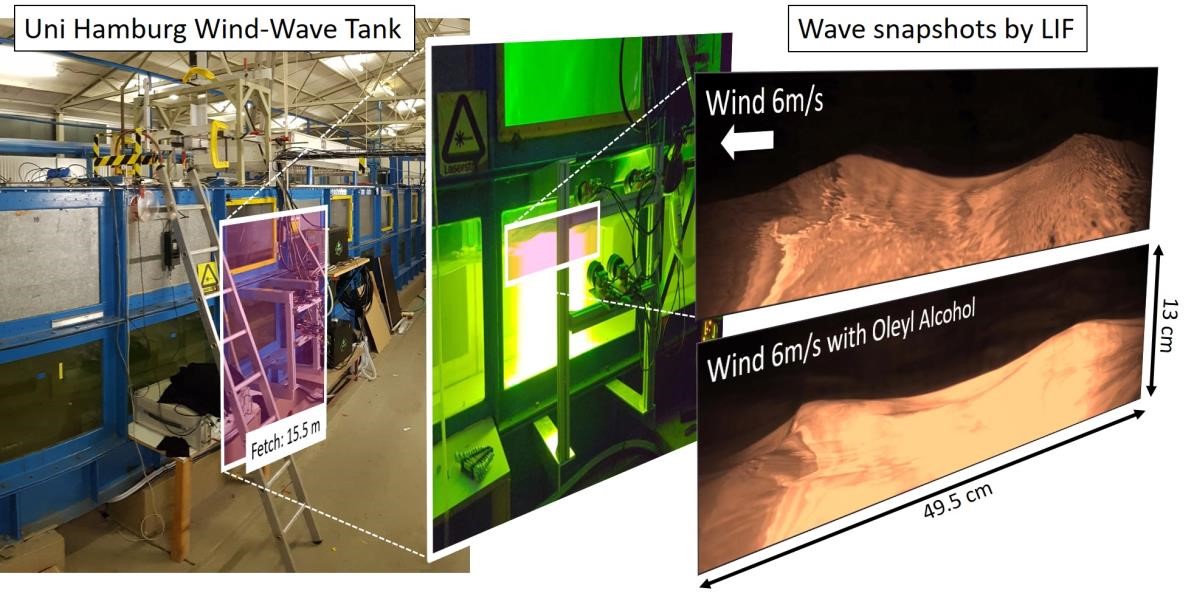
Figure 4. PIV and LIF in the wind-wave tank. Setup (left and middle) and example of LIF snapshots of waves with and without oleyl alcohol at the surface (right).
First tests of air- and water-side LDV
In a second, separate experiment, air- and water-side laser Doppler velocimetry (LDV) measurements provided wave-phase-resolved air-side turbulent flux measurements, which suggest that the surfactants strongly modify the structure of the turbulent (Reynolds) stress along the waves, as depicted in Figure 5.
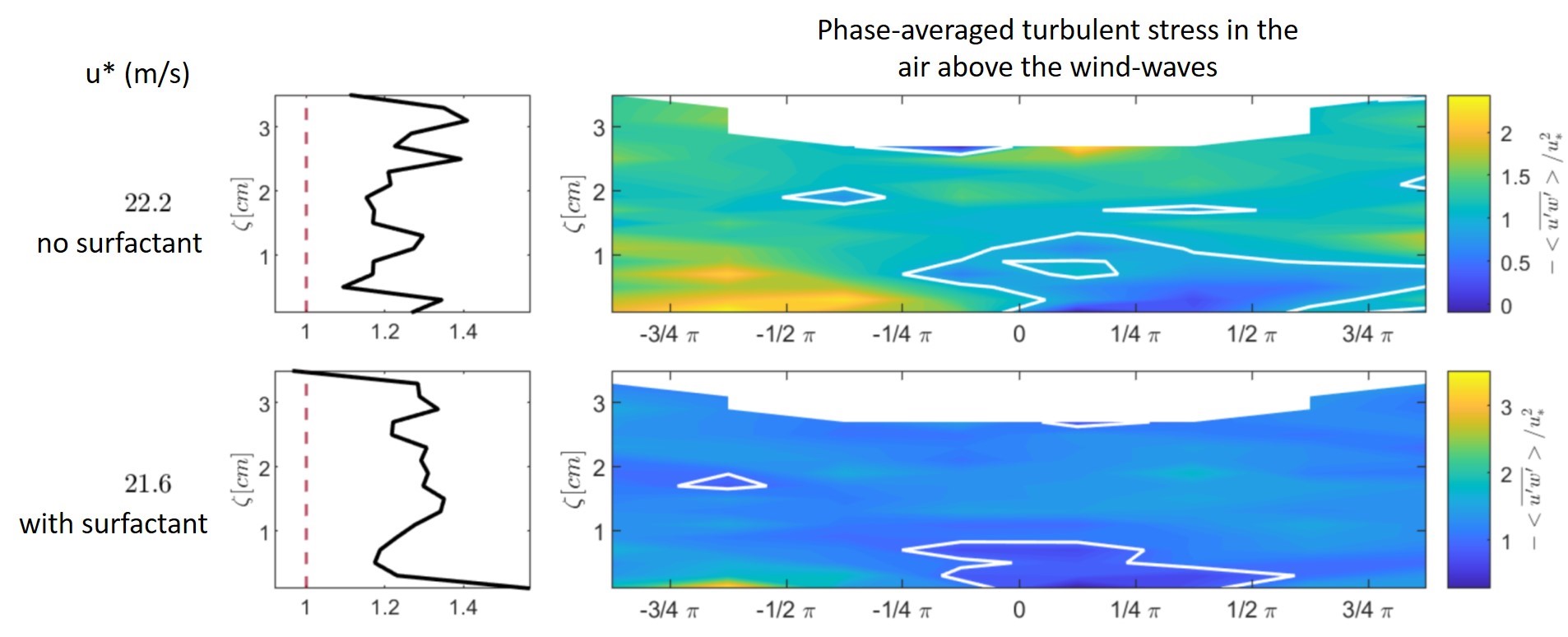
Figure 5. LDV measurements of mean (left) and phase-averaged (right) turbulent stress at height ζ above wind-waves in U Hamburg’s wind-wave tank, at a fetch of 15.5 m. Upper panels refer to measurements without surfactants, and lower panels refer to measurements with oleyl alcohol at the water surface.
Water-side LDV measurements revealed that, for a sufficiently high data quality, a larger amount of seeding particles (hence, a higher density of scatterers in the bulk water) is needed than for PIV measurements. It will remain to Tasks 1 and 2 (see below) to find optimal scatterer densities, both in the water and in the air, for successful simultaneous multi-instrument campaigns.
Objectives
Our research will focus on dynamic processes that determine fluxes of mass, energy, and momentum across the SML. Since these processes take place at spatial scales of centimeters and below, our main objectives are novel, simultaneous measurements at very fine scales, well below the length scales of the dynamic processes under investigation.
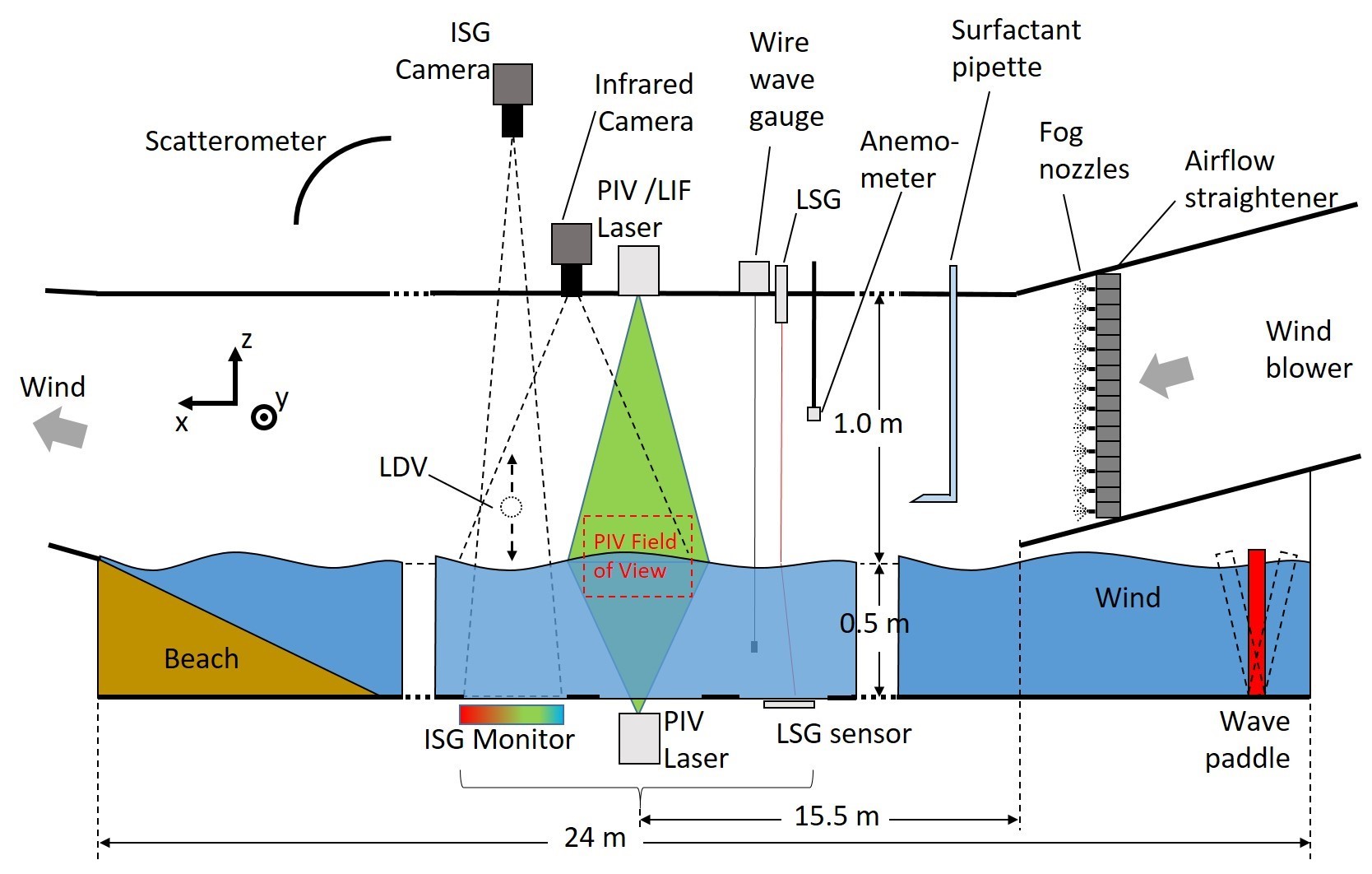
Figure 6. Sketch of the proposed experimental setup at University of Hamburg’s large wind-wave facility. (ISG: Imaging Slope Gauge, LSG: Laser Slope Gauge, PIV: Particle Image Velocimetry, LIF: Laser-Induced Fluorescence, LDV: Laser Doppler Velocimetry).
Ocean spray, an important source of chemical compounds in the atmosphere is caused by the interaction of wind and breaking waves, the frequency and strength of which are influenced by surfactants. We will quantify and understand the wind-wave-surfactant conditions in which breaking and resulting spray generation can be significant. During joint campaigns at the wind-wave tank, we will prepare for a more detailed investigation of spray and aerosol formation, to be performed in a later experimental phase.
Air-sea gas fluxes are controlled by complex feedback mechanisms, including coupled, air-wave-water processes, such as wave breaking, wave-induced viscous stress variations, and airflow separation, all of which are dramatically dependent upon the presence of surfactants. These processes will be experimentally investigated in the wind-wave tank using novel, state-of-the-art measurement techniques.
Breaking waves and related turbulence levels in the upper ocean affect temperature and salinity profiles and therefore control buoyancy fluxes and, hence, material transport into and from the SML. We will investigate the influence of surfactants within the SML on breaking wave statistics and related turbulence levels.
Central hypothesis
The complex, small-scale feedback mechanisms between wind, waves, and sea-surface monolayers need to be understood for improved analyses of other measurements of fluxes and exchange processes across the SML.
Hypothesis 1 – A sufficient, in-depth understanding of those small-scale mechanisms can only be achieved through dedicated laboratory campaigns involving quasi-simultaneous roughness and flow measurements at, above, and below the wavy water surface.
Hypothesis 2 – Surfactants show a strong impact on fluxes and exchange processes across the SML through a two-stage process involving the reduction of the wind stress on the SML and the suppression of micro-scale breaking.
Hypothesis 3 – Surfactants alter the phase-dependent viscous stress and pressure fields, both quantitatively and qualitatively, depending on their visco-elastic properties.
Hypothesis 4 – The spatio-temporal distribution of small-scale roughness patterns, and their evolution or suppression, are of key importance for a parameterization of fluxes and exchange processes across the SML.
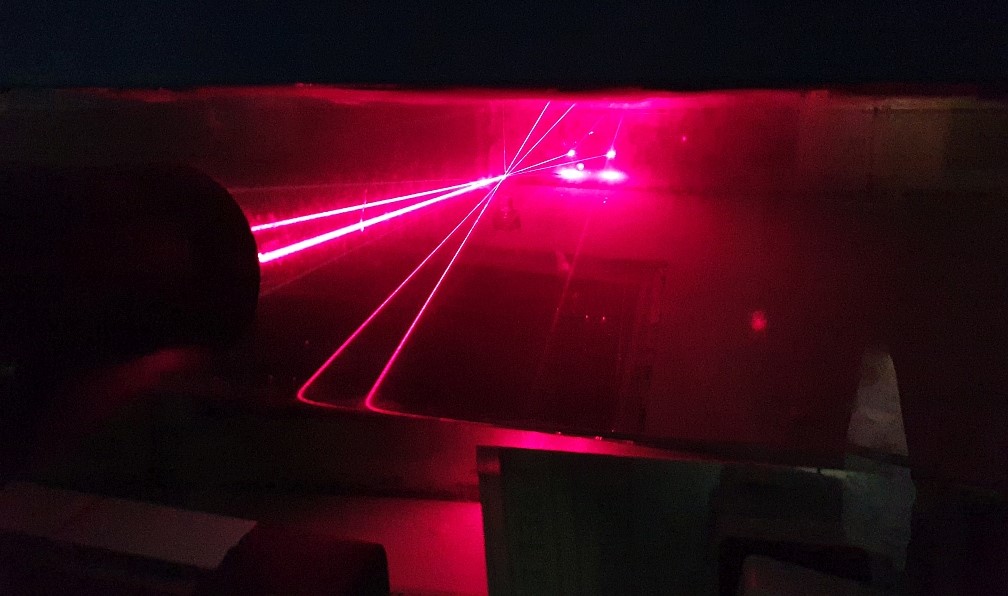
Figure 7. Wind-wave tank experiment with the LDV (left) located beside the wind-wave tank, looking into the air side in the tank and measuring velocities in the (xz) plane (cf. Figure 6).
References: Buckley, M.P., Veron, F. (2016) Structure of the airflow above surface waves. J. Phys. Ocean. 46(5), 1377-1397. Buckley, M.P., Veron, F. (2017) Airflow measurements at a wavy air–water interface using PIV and LIF. Exp. Fluids. 58(11), 161. Buckley, M.P., Veron, F. (2019) The turbulent airflow over wind generated surface waves. Eur. J. Mech. – B/Fluids 73, 132-143. Gade, M., Alpers, W., Hühnerfuss, H., Lange, P.A. (1998a) Wind-wave tank measurements of wave damping and radar cross sections in the presence of monomolecular surface films. J. Geophys. Res. 103, 3167-3178. Gade, M., Alpers, W., Ermakov, S.A., Hühnerfuss, H., Lange, P.A. (1998b) Wind-wave tank measurements of bound and freely propagating short gravity-capillary waves. J. Geophys. Res. 103, 21697-21710. Gade, M., Hühnerfuss, H., Korenowski, G.M. (Eds.) (2006) Marine Surface Films: Chemical Characteristics, Influence on Air-Sea Interactions, and Remote Sensing, Springer, Heidelberg, 342 pp. Gade, M., Byfield, V., Ermakov, S., Lavrova, O., Mitnik, L. (2013) Slicks as Indicators for Marine Processes. Oceanography 26(2), 138-149. Husain, N., Hara T., Buckley, M.P., Yousefi, K., Veron, F., Sullivan, P. (2019) Boundary layer turbulence over surface waves in a strongly forced condition - LES and Observation. J. Phys. Ocean. 49(8), 1997-2015. Savelyev, I., Buckley, M.P., Haus, B. (2019) The impact of nonbreaking waves on wind-driven ocean surface turbulence. J. Geophys. Res. Oceans. 125, e2019JC01557. Buckley, M.P., Veron, F., Yousefi, K. (2020) Surface viscous stress over wind-driven waves with intermittent airflow separation. J. Fluid Mech. 905

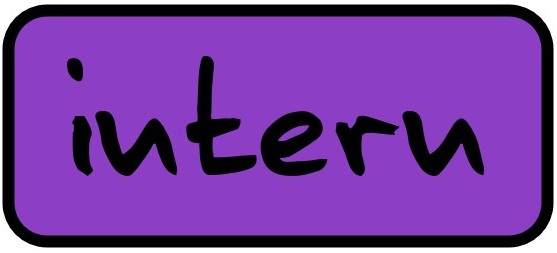 ...internal WWK pages this way.
...internal WWK pages this way. 
 ... back to the main KFEW3O page...
... back to the main KFEW3O page...
